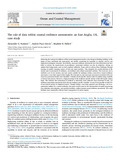JavaScript is disabled for your browser. Some features of this site may not work without it.
| dc.contributor.author | Rumson, Alexander G. | |
| dc.contributor.author | Payo Garcia, Andres | |
| dc.contributor.author | Hallett, Stephen H. | |
| dc.date.accessioned | 2020-01-28T15:20:48Z | |
| dc.date.available | 2020-01-28T15:20:48Z | |
| dc.date.issued | 2019-10-07 | |
| dc.identifier.citation | Rumson A, Payo Garcia A, Hallett S (2020) The role of data within Coastal Resilience Assessments: an East Anglia, UK, case study. Ocean and Coastal Management, Volume 185, March 2020, Article number 105004 | en_UK |
| dc.identifier.issn | 0964-5691 | |
| dc.identifier.uri | https://doi.org/10.1016/j.ocecoaman.2019.105004 | |
| dc.identifier.uri | http://dspace.lib.cranfield.ac.uk/handle/1826/15029 | |
| dc.description.abstract | Embracing the concept of resilience within coastal management marks a step change in thinking, building on the inputs of more traditional risk assessments, and further accounting for capacities to respond, recover and implement contingency measures. Nevertheless, many past resilience assessments have been theoretical and have failed to address the requirements of practitioners. Assessment methods can also be subjective, relying on opinion-based judgements, and can lack empirical validation. Scope exists to address these challenges through drawing on rapidly emerging sources of data and smart analytics. This, alongside the careful selection of the metrics used in assessment of resilience, can facilitate more robust assessment methods. This work sets out to establish a set of core metrics, and data sources suitable for inclusion within a data-driven coastal resilience assessment. A case study region of East Anglia, UK, is focused on, and data types and sources associated with a set of proven assessment metrics were identified. Virtually all risk-specific metrics could be satisfied using available or derived data sources. However, a high percentage of the resilience-specific metrics would still require human input. This indicates that assessment of resilience is inherently more subjective than assessment of risk. Yet resilience assessments incorporate both risk and resilience specific variables. As such it was possible to link 75% of our selected metrics to empirical sources. Through taking a case study approach and discussing a set of requirements outlined by a coastal authority, this paper reveals scope for the incorporation of rapidly progressing data collection, dissemination, and analytical methods, within dynamic coastal resilience assessments. This could facilitate more sustainable evidence-based management of coastal regions. | en_UK |
| dc.language.iso | en | en_UK |
| dc.publisher | Elsevier | en_UK |
| dc.rights | Attribution 4.0 International | * |
| dc.rights.uri | http://creativecommons.org/licenses/by/4.0/ | * |
| dc.subject | Coastal management | en_UK |
| dc.subject | Resilience metrics | en_UK |
| dc.subject | Geospatial data | en_UK |
| dc.subject | Open source data | en_UK |
| dc.subject | Big data | en_UK |
| dc.title | The role of data within Coastal Resilience Assessments: an East Anglia, UK, case Study | en_UK |
| dc.type | Article | en_UK |
Files in this item
The following license files are associated with this item:
This item appears in the following Collection(s)
-
Staff publications (SWEE) [2805]

